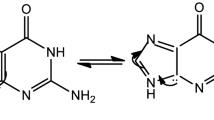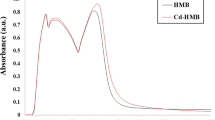Abstract
From reaction mixture containing the same reagents, the two Cu(II) complexes, with dicyanamide (dca) bridges, [Cu(bpy)(dca)2]n (1) and [Cu(bpy)Cl(dca)]n·H2O (2) (bpy = 2,2′-bipyridine) were prepared. The complexes were characterized by elemental analysis, FTIR spectroscopy and X-ray single crystal techniques. In both complexes, the geometry of the Cu(II) atom is best described as a slightly distorted square pyramidal. A zigzag chain structure is formed in both structures by dca units serving as an end-to-end bridging ligand. In addition, studies on antibacterial activity of the compounds against Gram(+) (Staphylococcus aureus ATCC-6538) and Gram(–) (Escherichia coli ATTC-8739, Pseudomonas aeruginosa ATCC-27853 and Enterobacter aerogenes ATCC-13048) bacteria have been performed using disc-diffusion and microdilution broth techniques. Both complexes were found to be significantly more effective against Gram(–) bacteria E. Coli than against the other bacteria.






Similar content being viewed by others
REFERENCES
S. R. Batten and K. S. Murray. Structure and magnetism of coordination polymers containing dicyanamide and tricyanomethanide. Coord. Chem. Rev., 2003, 246(1/2), 103-130. https://doi.org/10.1016/s0010-8545(03)00119-x
D. Sadhukhan, A. Ray, R. J. Butcher, C. J. Gómez García, B. Dede, and S. Mitra. Magnetic and catalytic properties of a new copper(II)–Schiff base 2D coordination polymer formed by connected helical chains. Inorg. Chim. Acta, 2011, 376(1), 245-254. https://doi.org/10.1016/j.ica.2011.06.024
K. Bhar, S. Chattopadhyay, S. Khan, R. K. Kumar, T. K. Maji, J. Ribas, and B. K. Ghosh. Syntheses, structures and magnetic properties of μ1,5 dicyanamide bridged coordination polymers of copper(II) and nickel(II) containing a tetradentate N-donor Schiff base. Inorg. Chim. Acta, 2011, 370(1), 492-498. https://doi.org/10.1016/j.ica.2011.02.055
P. Talukder, S. Shit, A. Sasmal, S. R. Batten, B. Moubaraki, K. S. Murray, and S. Mitra. An antiferromagnetically coupled hexanuclear copper(II) Schiff base complex containing phenoxo and dicyanamido bridges: Structural aspects and magnetic properties. Polyhedron, 2011, 30(11), 1767-1773. https://doi.org/10.1016/j.poly.2011.03.049
O. Costisor, K. Mereiter, M. Julve, F. Lloret, Y. Journaux, W. Linert, and M. Andruh. Synthesis, crystal structure and magnetic properties of [Cu(bipy)2(CH3COO)][Cu(bipy)2(Cr(C2O4)3)]·~10.5H2O, the first compound containing the [Cr(C2O4)3]3− building block acting as a monodentate ligand. Inorg. Chim. Acta, 2001, 324(1/2), 352-358. https://doi.org/10.1016/s0020-1693(01)00569-2
R. Li, J. Lu, D. Li, S. Cheng, and J. Dou. Syntheses, structures, in vitro cytotoxicities and DNA-binding properties of four copper complexes based on a phenyl 2-pyridyl ketoxime ligand. Transition Met. Chem., 2014, 39(5), 507-517. https://doi.org/10.1007/s11243-014-9826-9
F. A. Mautner, C. N. Landry, A. A. Gallo, and S. S. Massoud. Molecular structure of mononuclear azido- and dicyanamido-Cu(II) complexes. J. Mol. Struct., 2007, 837(1-3), 72-78. https://doi.org/10.1016/j.molstruc.2006.10.005
S. R. Marshall, C. D. Incarvito, W. W. Shum, A. L. Rheingold, and J. S. Miller. Novel coordination of dicyanamide, [N(CN)2]−: preferential binding of the amide nitrogen. Chem. Commun., 2002, (24), 3006/3007. https://doi.org/10.1039/b208872j
A. Mohamadou, G. A. van Albada, H. Kooijman, B. Wieczorek, A. L. Spek, and J. Reedijk. The binding mode of the ambidentate ligand dicyanamide to transition metal ions can be tuned by bisimidazoline ligands with H-bonding donor property at the rear side of the ligand. New J. Chem., 2003, 27(6), 983. https://doi.org/10.1039/b212059c
D. Mal, C. Adhikary, E. Rentschler, Y. Miyashita, K.-I. Okamoto, and S. Koner. Synthesis, X-ray crystal structure and magnetic study of the 1D {[Cu(N,N-diethyl-1,2-ethanediamine)(μ1,5-dca)(dca)]}n complex. Polyhedron, 2007, 26(3), 736-740. https://doi.org/10.1016/j.poly.2006.08.037
E. Colacio, I. Ben Maimoun, F. Lloret, and J. Suárez-Varela. [Ni(cyclam)(μ1,3-dca)2Cu(μ1,5-dca)2]: A genuine 3D bimetallic coordination polymer containing both μ1,3- and μ1,5-bidentate dicyanamide bridges and a ferromagnetic interaction between copper(II) and nickel(II) Ions. Inorg. Chem., 2005, 44(11), 3771-3773. https://doi.org/10.1021/ic050369v
J. Carranza, J. Sletten, F. Lloret, and M. Julve. Structural analysis and magnetic properties of the copper(II) dicyanamide complexes [Cu2(dmphen)2(dca)4], [Cu(dmphen)(dca)(NO3)] and [Cu(4,4′-dmbpy)(H2O)(dca)2] (dca = dicyanamide; dmphen = 2,9-dimethyl-1,10-phenanthroline; 4,4′-dmbpy=4,4′-dimethyl-2,2′-bipyr. Inorg. Chim. Acta, 2004, 357(11), 3304-3316. https://doi.org/10.1016/j.ica.2004.01.044.
J. Luo, M. Hong, J. Weng, Y. Zhao, and R. Cao. The complexes with end-to-end dicyanamide bridges: syntheses, characterization and crystal structures of [Cu(μ1,5-dca)2(phen)]n and [Cd(μ1,5-dca)2(py)2]n (phen = phenanthroline; py = pyridine; dca = dicyanamide, N(CN)2−). Inorg. Chim. Acta, 2002, 329(1), 59-65. https://doi.org/10.1016/s0020-1693(01)00794-0
A. Escuer, F. A. Mautner, N. Sanz, and R. Vicente. Two new one-dimensional compounds with end-to-end dicyanamide as a bridging ligand: syntheses and structural characterization of trans-[Mn(4-bzpy)2(N(CN)2)2]n and cis-[Mn(Bpy)(N(CN)2)2]n, (4-bzpy = 4-benzoylpyridine; bpy = 2,2′-bipyridyl). Inorg. Chem., 2000, 39(8), 1668-1673. https://doi.org/10.1021/ic990905h.
Y.-J. Shi, L.-H. Li, Y.-Z. Li, X.-T. Chen, Z. Xue, and X.-Z. You. Syntheses and structures of two one-dimensional double-stranded lead polymers of dicyanamide with unusual coordination mode. Polyhedron, 2003, 22(6), 917-923. https://doi.org/10.1016/s0277-5387(03)00030-5
B. Vangdal, J. Carranza, F. Lloret, M. Julve, and J. Sletten. Syntheses, crystal structures and magnetic properties of copper(II) dicyanamide complexes; dinuclear, chain and ladder compounds. J. Chem. Soc., Dalton Trans., 2002, (4), 566-574. https://doi.org/10.1039/b105981p
L. Váhovská, I. Potočňák, S. Vitushkina, M. Dušek, J. Titiš, and R. Boča. Low-dimensional compounds containing cyanido groups. XXVI. Crystal structure, spectroscopic and magnetic properties of Co(II) complexes with non-linear pseudohalide ligands. Polyhedron, 2014, 81, 396-408. https://doi.org/10.1016/j.poly.2014.06.046
Q. Shi, L. Sheng, K. Ma, Y. Sun, X. Cai, R. Liu, and S. Wang. Two 2-D homometallic and heterometallic Schiff-base complexes bridged by dicyanamide. Inorg. Chem. Commun., 2009, 12(3), 255-258. https://doi.org/10.1016/j.inoche.2008.12.024
R. Li, J. Lu, D. Li, S. Cheng, and J. Dou. Syntheses, structures, in vitro cytotoxicities and DNA-binding properties of four copper complexes based on a phenyl 2-pyridyl ketoxime ligand. Transition Met. Chem., 2014, 39(5), 507-517. https://doi.org/10.1007/s11243-014-9826-9
Y. Xu, Y. Wang, Y. Zhong, G. Lei, Z. Li, J. Zhang, and T. Zhang. High-energy metal–organic frameworks with a dicyanamide linker for hypergolic fuels. Inorg. Chem., 2021, 60(7), 5100-5106. https://doi.org/10.1021/acs.inorgchem.1c00109
H.-H. Xie, Q. Wang, J.-L. Weng, Y.-F. Yan, H.-Y. Bian, Y. Huang, F.-K. Zheng, R.-H. Qiu, and J.-G. Xu. Coordination polymerization of nitrogen-rich linkers and dicyanamide anions toward energetic coordination polymers with low sensitivities. Dalton Trans., 2023, 52(3), 818-824. https://doi.org/10.1039/d2dt03180a
M. Li, X.-Y. Qiu, Z.-X. Zheng, and Y.-J. Wu. Syntheses and crystal structures of copper(II) and zinc(II) complexes derived from 5-bromo-2-((cyclopropylimino)methyl)phenol with antibacterial activity. J. Struct. Chem., 2023, 64(3), 347-364. https://doi.org/10.1134/s0022476623030022
C. Hopa and I. Cokay. Synthesis, structural characterization and thermal properties of a new copper(II) one-dimensional coordination polymer based on bridging N,N′-bis(2-hydroxybenzylidene)-2,2-dimethylpropane-1,3-diamine and dicyanamide ligands. Acta Crystallogr., Sect. C: Struct. Chem., 2016, 72(2), 149-154. https://doi.org/10.1107/s2053229616000978
C. Hopa and I. Cokay. Designing a heterotrinuclear CuII–NiII–CuII complex from a mononuclear CuII Schiff base precursor with dicyanamide as a coligand: synthesis, crystal structure, thermal and photoluminescence properties. Acta Crystallogr., Sect. C: Struct. Chem., 2016, 72(8), 601-606. https://doi.org/10.1107/s205322961600944x
SAINT (V7.68A). Madison, Wisconsin, USA: Bruker AXS Inc., 2009.
SADABS (V2008/1). Madison, Wisconsin, USA: Bruker AXS Inc., 2008.
G. M. Sheldrick. Crystal structure refinement with SHELXL. Acta Crystallogr., Sect. C: Struct. Chem., 2015, 71(1), 3-8. https://doi.org/10.1107/s2053229614024218
G. M. Sheldrick. A short history of SHELX. Acta Crystallogr., Sect. A: Found. Crystallogr., 2008, 64(1), 112-122. https://doi.org/10.1107/s0108767307043930
C. F. Macrae, I. Sovago, S. J. Cottrell, P. T. A. Galek, P. McCabe, E. Pidcock, M. Platings, G. P. Shields, J. S. Stevens, M. Towler, and P. A. Wood. Mercury 4.0: from visualization to analysis, design and prediction. J. Appl. Crystallogr., 2020, 53(1), 226-235. https://doi.org/10.1107/s1600576719014092
I. Potočňák, M. Burčák, C. Wagner, and L. Jäger. Low-dimensional compounds containing cyano groups. II. catena-Poly[[(2,2′-bipyridine-κ2N:N′)(dicyanamido-κN)copper(II)]-μ-dicyanamido-κ2N:N′]. Acta Crystallogr., Sect. C: Cryst. Struct. Commun., 2002, 58(6), m327-m329. https://doi.org/10.1107/s0108270102006625
A. W. Addison, T. N. Rao, J. Reedijk, J. van Rijn, and G. C. Verschoor. Synthesis, structure, and spectroscopic properties of copper(II) compounds containing nitrogen–sulphur donor ligands; the crystal and molecular structure of aqua[1,7-bis(N-methylbenzimidazol-2′-yl)-2,6-dithiaheptane]copper(II) perchlorate. J. Chem. Soc., Dalton Trans., 1984, (7), 1349-1356. https://doi.org/10.1039/dt9840001349
I. Castro, M. L. Calatayud, J. Sletten, F. Lloret, and M. Julve. Crystal structures and magnetic properties of the squarate-O1,On-bridged dinuclear copper(II) complexes [Cu2(phen)4(C4O4)](CF3SO3)2·3H2O (n = 2) and [Cu2(bipy)4(C4O4)](CF3SO3)2·6H2O (n = 3). Inorg. Chim. Acta, 1999, 287(2), 173-180. https://doi.org/10.1016/s0020-1693(99)00011-0.
N. Nakomato. Infrared and Raman Spectra of Inorganic and Coordination Compounds, 6th ed. New Jersey, USA: John Wiley & Sons, 2009.
S. Biswas, C. Diaz, and A. Ghosh. The first triple phenoxido-bridged triangular NiIICuII2 complexes with a N2O2 donor di-Schiff base and pseudohalide (N(CN)2− or NCS−) ligands: Structural analyses and magnetic properties. Polyhedron, 2013, 51, 96-101. https://doi.org/10.1016/j.poly.2012.12.019
L. Viganor, O. Howe, P. McCarron, M. McCann, and M. Devereux. The antibacterial activity of metal complexes containing 1,10- phenanthroline: potential as alternative therapeutics in the era of antibiotic resistance. Curr. Top. Med. Chem., 2017, 17(11), 1280-1302. https://doi.org/10.2174/1568026616666161003143333
Y. Xu, Y. Shi, F. Lei, and L. Dai. A novel and green cellulose-based Schiff base-Cu(II) complex and its excellent antibacterial activity. Carbohydr. Polym., 2020, 230, 115671. https://doi.org/10.1016/j.carbpol.2019.115671
B. Nazirkar, M. Mandewale, and R. Yamgar. Synthesis, characterization and antibacterial activity of Cu(II) and Zn(II) complexes of 5-aminobenzofuran-2-carboxylate Schiff base ligands. J. Taibah Univ. Sci., 2019, 13(1), 440-449. https://doi.org/10.1080/16583655.2019.1592316
E. Pahontu, F. Julea, T. Rosu, V. Purcarea, Y. Chumakov, P. Petrenco, and A. Gulea. Antibacterial, antifungal and in vitro antileukaemia activity of metal complexes with thiosemicarbazones. J. Cell. Mol. Med., 2015, 19(4), 865-878. https://doi.org/10.1111/jcmm.12508
W.-L. Wang, S. C. Chai, M. Huang, H.-Z. He, T. D. Hurley, and Q.-Z. Ye. Discovery of inhibitors of escherichia coli methionine aminopeptidase with the Fe(II)-form selectivity and antibacterial activity. J. Med. Chem., 2008, 51(19), 6110-6120. https://doi.org/10.1021/jm8005788
Author information
Authors and Affiliations
Corresponding author
Ethics declarations
The authors declare that they have no conflicts of interests.
Additional information
Text © The Author(s), 2023, published in Zhurnal Strukturnoi Khimii, 2023, Vol. 64, No. 9, 118094.https://doi.org/10.26902/JSC_id118094
Rights and permissions
About this article
Cite this article
Hopa, C., Yavuz, A.B., Diken, M.E. et al. Cu(II) COORDINATION POLYMERS CONTAINING DICYANAMIDE AND 2,2′-BIPYRIDINE: STRUCTURAL AND ANTIBACTERIAL PROPERTIES. J Struct Chem 64, 1768–1779 (2023). https://doi.org/10.1134/S0022476623090202
Received:
Revised:
Accepted:
Published:
Issue Date:
DOI: https://doi.org/10.1134/S0022476623090202




